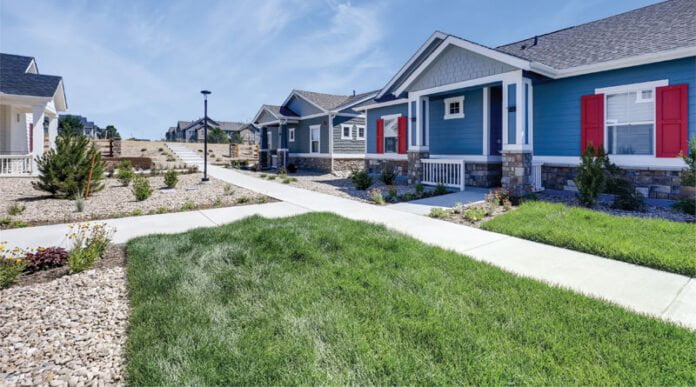Single-family housing is by far the most popular type of housing in the United States. According to the American Community Survey, nearly 62% of Americans lived in a single-family detached home in 2017, a percentage that has held steady since at least 2009.
Even in the rental market, where multifamily reigns, single-family housing has a respectable hold: 35% of renter households lived in a single-family home, according to ACS data.
Around the country, large builders are experimenting with increasing the share of single-family rentals. Lennar announced on a second-quarter earnings call that it will be the builder for a rental-only neighborhood in Florida, while in the West, Toll Brothers and Taylor Morrison have announced their own forays into the rental market.
Challenges for single-family rental builders
Despite these large builders leading the charge on single-family rentals, Robert Dietz, chief economist at the National Association of Home Builders, reminds builders that single-family homes built specifically for the rental market still account for a small share of total housing inventory.
“There are some who believe this is a really significant part of single-family disruption, and it’s just not,” he cautioned in an interview with Colorado Builder.
RELATED: Smart Home Energy Revolution
Dietz explained that between 1992 and 2012, the share of BFR homes was about 2.7% of total starts. Today, that’s risen to almost 5%. In the third quarter of 2019, starts for single-family homes built for rent fell slightly: 11,000, down from an estimated 14,000 in the third quarter of 2018.
“It’s not quite doubled over its historic norms, so you can easily view it as elevated, but it remains a small share,” he said.
Meanwhile, multifamily housing, where typically 80% of starts are earmarked for rentals, increased to about 95%, Dietz said.
“That part of the market really has moved in a very significant way to being essentially almost entirely dominated by rental,” he said.
Affordability is one factor in the increased interest in rental housing, Dietz noted.
“The biggest issue in housing over the last year, year and a half, has certainly been the housing affordability crunch that kicked into the marketplace last fall and ended in the spring,” he said. “We saw a bit of a reversal on housing demand, where the for-sale side of the market weakened and the demand for rental units has grown.”
Some builders may be dissuaded from building rental communities by worries about the return on their investments, according to Devyn Bachman, a research manager at John Burns Real Estate Consulting.
“I’ve seen in a number of the earnings calls … a lot of chatter about these big announcements,” Bachman said in an interview. “The answer from a lot of the builders is that it’s very hard to make the numbers work because land is so valuable and so expensive that it’s really hard to turn it into a rental asset because the return is not there that they could get if they sold a home.”
Balancing affordability with amenities
As communities around the country struggle with housing affordability, renting is an appealing alternative to a lot of different demographics. However, the decision to rent instead of buy a home can’t be written off solely as a matter of finances.
The Joint Center for Housing Studies at Harvard University found that one of the largest groups of renters is people with annual incomes of $75,000 or more. Over the last eight years, the organization’s 2019 State of the Nation’s Housing report found, consumers in that income group have increasingly opted to rent, increasing 66% since 2010. Today, over a quarter of renters make at least $75,000 a year, up from 19% in 2008.
Jacque Petroulakis, executive vice president of marketing and investor relations for NexMetro, a developer of luxury leased single-family housing in Arizona, Colorado, Florida and Texas, says “our residents are renters by choice.”
NexMetro’s Avilla Homes communities have the usual amenities—pool, clubhouse, onsite professional management—but the most distinctive amenity for a rental community is the private backyard at each home.
“This is definitely an innovative lifestyle choice for people wanting the best of both worlds,” Petroulakis said of Avilla Homes residents. “It’s four walls of freedom.”
JBRE’s Bachman pointed out that while home prices are certainly still challenging, affordability “dramatically improved” in 2019. Home price appreciation has slowed down significantly, while mortgage rates have dropped by 100 basis points and income growth has steadily increased, she said.
“Yes, affordability in Denver is challenged compared to Denver’s own history, but compared to six months to a year ago, affordability has actually improved,” she pointed out.
Some shoppers are not willing to compromise on location just to be a homeowner, she said.
“Take Denver—they can’t afford to [buy] in Highlands or LoHi or RiNo, but they want to live there,” Bachman said of home shoppers, “so they’re going to rent with three of their buddies a single-family rental home that’s 40 years old, that has no finishes, etc.”
3 reasons for single-family rental enthusiasm
Aging out of ownership. Older Americans, who also tend to have higher incomes, account for more than a quarter of renters, according to JCHS.
Boomers and older Gen Xers may be looking at downsizing not just their home but their lifestyle. They don’t want to deal with home maintenance, and if they have adult children, they may not feel as tied to a neighborhood or school district as they once did.
Bachman noted that this cohort is an ideal target for rental operators because they tend to stay in their rental home for much longer than younger renters.
“On average, baby boomer renters stay in place for an average of 8.4 years compared to 3.2 years for younger millennials,” she said. “It’s advantageous for the single-family rental operators to target the older cohorts because it’s going to be a much more stable renter.”
Erik Heuser, executive vice president and chief strategy officer of Taylor Morrison, counts generational demographics among the reasons for growing appetite for dedicated rental communities. He noted that between the boomer and millennial generations, “you’ve got over 150 million people who are going to be experiencing, for those who haven’t yet, significant life change.”
He told us, “For boomers, a lot of them are empty nesters. … For millennials, when you’ve got two dogs and two kids, it’s hard to live in an apartment or move into mom’s basement.”
Goodbye, white picket fence. A more profound change driving rental trends is a wider cultural shift that doesn’t prioritize owning a home as much as it did for older generations.
NexMetro’s Petroulakis said today’s home shoppers are “seeking a new American Dream really untethered by the responsibilities of homeownership. They want to live on their own terms … and at the same time, they value their personal space and privacy.”
JBRE’s Bachman agrees that the “American Dream” means something new.
“It’s okay to not be a homeowner anymore,” she said. “Now the American Dream is a roof over your head and somewhere cool to live, and that doesn’t need to [include home] ownership.”
The Great Recession played a big part in dismantling that aspect of the American Dream, Bachman suggested. Regardless of age, Americans saw friends and neighbors lose their homes, or lost their own, dashing the ideal of homeownership as a source of stability. If owning your home won’t prevent you from losing it, why not rent?
Tech gets a word in. Technology is playing its part in, if not making renting more appealing, at least making it more accessible than buying.
“Now you can go up to a single-family rental home, you can use a code on your phone to unlock the home, you can walk inside and you can take a self-guided tour—you don’t need anyone to help you do this,” Bachman said. When everything from applications to showings can be done with a smartphone, the traditional steps to buying a house start to look like a bigger burden than would-be buyers want to take on.
Who’s building
Typically, rental home inventory comprises older homes rented by owners, and new homes that couldn’t be sold and were converted into a rental property. Homes built specifically to be rented are part of a new concept with a lot of uncertainty.
“We’re not calling it single-family rental, we’re calling it built-for-rent,” Bachman said.
As builders and operators test the rental waters, she anticipates companies will establish partnerships to capitalize on what each does best.
“This built-for-rent concept is so new that it’s really hard to say what operators are going to do,” she said. “I think we’re going to see a lot of partnerships like the Toll Brothers partnership where [builders] say, ‘We know how to build a home,’ and then their partners, the single-family rental operators, are going to say, ‘Well, we know how to rent, manage and maintain that.’”
Taylor Morrison’s Heuser agreed, noting there are two main ways builders are getting into the rental market. One is to continue building individual homes on individual lots; “you can sell that into a portfolio, you can sell it to American Homes 4 Rent, you can sell it to Mr. and Mrs. Smith.”
“The other model is what we’re preliminarily going after,” he continued. “You buy a 12-acre tract of land, and you get high density on it. You produce a nice amenity that’s gated, high technology, high social programming, but the whole community is in a single plat.”
Builders then sell the community to an investor or real estate investment trust, “so you’re producing this one thing that’s in a nice, tidy package.”
His firm chose to partner with Christopher Todd Communities because the company “has a playbook that’s proven; they’ve got products, they’ve got the site plan, they’ve got a lot of the kinks worked out.”
NAHB’s Dietz believes there’s a regional effect to interest in the BFR market. In the past, he said, most BFR activity has occurred in the West South Central region: Arkansas, Louisiana, Oklahoma, Texas. High-volume housing markets like the Pacific region only had a 6% share, he said.
“I think we’re going to see the Pacific share rise. There’s growth in building single-family rentals there on the West Coast; some of that could translate into markets like Vegas, like parts of Colorado, where you do have rising housing affordability challenges.”
NexMetro’s Petroulakis said that “Denver was a must in terms of markets to expand into.” The company has three communities: Buffalo Run in Commerce City, Prairie Center in Brighton, and the new Eastlake in Thornton, expected to open in early 2020. The company has invested $140 million in those three projects, Petroulakis said. The one-, two- and three-bedroom homes lease for between $1,520 and $2,316, she said.
“Denver is, first of all, just a great place to live,” she explained, but it also has “exceptional employment expansion, continued population growth, a lot of supply and demand opportunity for high-quality rental homes—the Denver market is quite ideal.”







